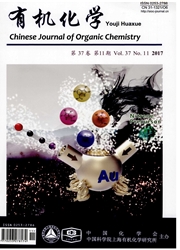

 中文摘要:
中文摘要:
基于二硝基苯醚的硫解反应识别机制,设计合成了羟基芘甲醛为荧光基团的探针分子8-(2,4-二硝基苯酚基)芘甲醛(PCNP),研究了PCNP缓冲溶液分散体系对H_2S的响应.未与H_2S作用时,分子内光致电子转移过程导致探针分子PCNP几乎不发光,当体系中存在H2S时,PCNP发生硫解反应,光致电子转移过程被阻断,羟基芘甲醛发出橙色荧光.PCNP分子对H2S响应迅速、灵敏,0.1 mmol·L-1硫化氢存在下10 min内荧光强度响应达到最大值,荧光增强达260倍,反应速率常数为0.20 min-1,探针分子对H2S检测限为0.10μmol·L-1,并且具有良好选择性.
 英文摘要:
英文摘要:
A reaction-based probe 8-(2,4-dinitrophenoxy)pyrene-1-carbaldehyde(PCNP) for H2S detection was designed and synthesized by utilizing 8-hydroxypyrene-1-carbaldehyde and dinitrophenyl ether as the reporting chromophore and the recognition unit, respectively. The probe was dissolved in phosphate buffer saline(PBS) with cetyltrimethyl ammonium bromide(CTAB), and the sensing ability toward H2S was investigated with steady-state spectroscopy. The emission of PCNP was quenched by photoinduced electron transfer without H2S. The fluorescence of PCNP was boosted after thiolysis reaction in the presence of H2S, showing orange red emission. The fluorescence response was rapid and reached a maximum enhancement of about 260 times in the presence of 0.1 mmol·L-1 H2S, giving a reaction rate constant of 0.20 min-1. The limit of detection of PCNP is estimated to be 0.10 μmol·L-1. The results demonstrate that PCNP is capable of detecting H_2S rapidly, sensitively and selectively.
 同期刊论文项目
同期刊论文项目
 同项目期刊论文
同项目期刊论文
 Tetrathiafulvalene Terminal-Decorated PAMAM Dendrimers for Triggered Release Synergistically Stimula
Tetrathiafulvalene Terminal-Decorated PAMAM Dendrimers for Triggered Release Synergistically Stimula 期刊信息
期刊信息
